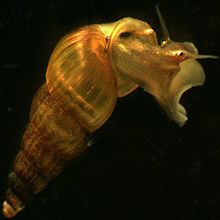Scientific name Oncomelania | Superfamily Rissooidea Subfamily Pomatiopsinae Higher classification Pomatiopsinae Rank Genus | |
 | ||
Similar Oncomelania hupensis, Schistosoma japonicum, Bulinus, Biomphalaria, Schistosoma haematobium | ||
Oncomelania is a genus of very small tropical freshwater snails, aquatic gastropod mollusks in the family Pomatiopsidae.
Contents
These Oncomelania snails are distantly related to the marine periwinkle, and more closely related to the small marine snails of the family Rissoidae.
Species
There are two species in the genus Oncomelania:
Woodruff et al. (1999) recognized also the following species:
Japanese Red List Data Book (2006) recognizes also the following additional species:
Distribution
This genus has not yet become established in the USA, but it is considered to represent a potentially serious threat as a pest, an invasive species which could negatively affect agriculture, natural ecosystems, human health or commerce. Therefore, it has been suggested that this species be given top national quarantine significance in the USA.
Evolution
About the origin and evolution history of Oncomelania, Davis (1979) proposed a Gondwanan origin for the Pomatiopsidae, with rafting to mainland Asia via the Indian Craton after break-up of Gondwanan and colonization of South-East Asia and China. It is hypothesized that Oncomelania snails, arrived in southwestern China from Indian before the second (major) Tibetan orogeny (2.5 Ma), then evolved and spread down their respective river systems, to mainland of China, Indonesia and Philippines. Although mutation rate calibrations using fossil data is impossible here, many studies have demonstrated the confidence that molecular data can provide reasonable estimates of divergence time. Data by Zhao et al. (2010) suggested that the two subspecies of Oncomelania hupensis began to diverse as early about 2–6 Ma based on the invertebrate ITS substitution rate range. Zhao et al. (2010) did not find any strong molecular and fossil evidences about Oncomelania evolution, but the reported Oncomelania fossil found in Guangxi (1 Ma) by Nils Hjalmar Odhner in 1930 and geological movement make this diversification time reasonable. It provides a new insight into the Oncomelania evolution history although the substitution rate needs to be verified with new fossil and molecular data in future study.
Parasites
Various Oncomelania species are significant medically, because they can serve as vectors for two serious human diseases: they can carry the schistosomiasis blood fluke parasite, and the paragonimus lung fluke parasites.
The miracidia reproduce asexually through sporocyst stages within these intermediate hosts, resulting in the production of many free-swimming cercariae.
